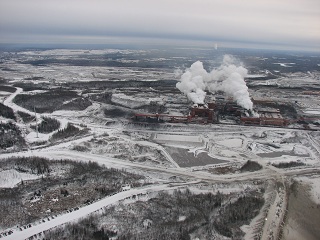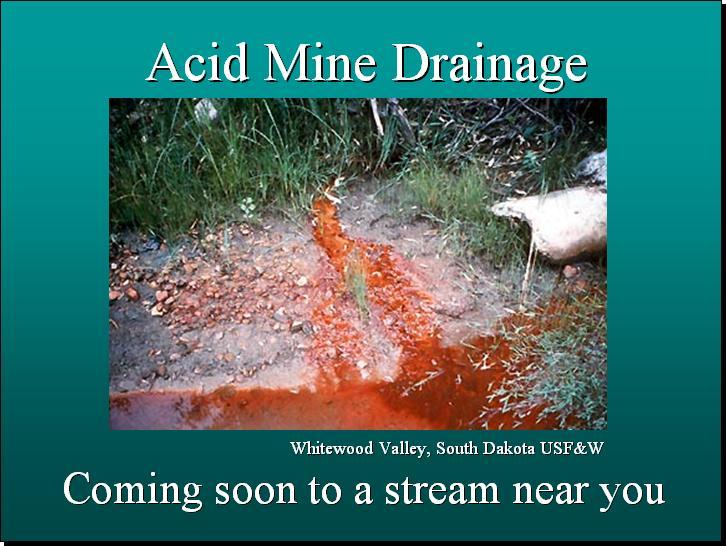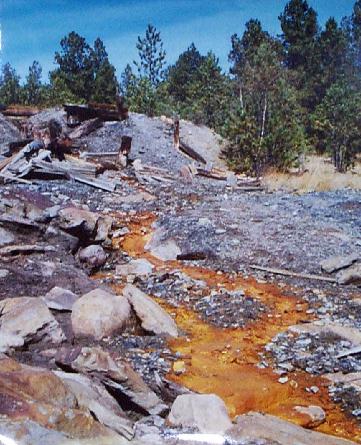Archive
The comment period has closed - Go HERE
**********
PolyMet - NorthMet Update 2010
The DNR, the US Army Corps of Engineers (USACE), and the US Forest Service (USFS) are working as co-lead agencies in the preparation of a Supplemental Draft Environmental Impact Statement (EIS). The DNR and the USACE announced their intent to prepare a Supplemental Draft EIS in a June 24, 2010 news release. More info HERE
The USFS has now joined as a co-lead agency and as the decision maker on a proposed USFS-PolyMet land exchange. The USFS and USACE published a Notice of Intent to prepare an SDEIS including the land exchange in the Federal Register on October 13, 2010. The USFS and USACE will take public comment on the SDEIS scope through November 29, 2010. Details of the scoping process and how to comment can be found at the USFS Web site.
This comment period has closed
**********
PolyMet's Draft Environmental Impact Statement (DEIS) released
Comment period ends at 4:30 p.m. on Wednesday, February 3, 2010
If approved, PolyMet would be the first ever copper-nickel sulfide mine permitted in Minnesota. Numerous organizations and individuals have sent requests to the cooperating agencies to extend the public comment period and to add additional public meeting locations.
Action! Request that 180 days be allowed for the public to comment on the Draft Environmental Impact Statement (“DEIS”) for the proposed PolyMet NorthMet open pit sulfide mine project within the Superior National Forest in Minnesota.
Click to see the Sierra Club's PolyMet Comment Extension Letter
Submit a quick comment requesting an extension of the comment period at the following website:
Action! Submit comments on PolyMet's Draft Environmental Impact Statement (“DEIS”) by February 3rd, 2010.
Click to see "Commenting on the PolyMet-DEIS"
Click to see "A Woman’s Perspective on the PolyMet DEIS"
Send more substantial comments to the following:
or to
From the Minnesota Department of Natural Resources Website
MDNR PolyMet's NorthMet EIS Site
PolyMet Mining Inc./NorthMet Project
PolyMet Mining, Inc. (PolyMet) proposes to develop an open pit mine and to refurbish and modify the former LTV Steel Mining taconite ore processing facility to extract copper metal and precipitates of nickel, cobalt and precious metals near Babbitt and Hoyt Lakes in northeastern Minnesota. The DNR and the U.S. Army Corps of Engineers are preparing a joint Environmental Impact Statement (EIS) that will satisfy both state and federal environmental review requirements.
The DNR released the Draft EIS for public comment period on Nov. 2 with a notice of availability published in the Nov. 2 issue of the EQB Monitor. The U.S. Army Corps of Engineers’ notice appeared in the Nov. 6 Federal Register. Public information meetings were held on Dec. 9 in Aurora, Minnesota, and on Dec. 10 in Blaine, Minnesota. Both agencies’ comment periods end at 4:30 p.m. on Wednesday, February 3, 2010.
Draft Environmental Impact Statement (EIS)
Nov. 2 issue of the EQB Monitor
More details regarding the comment period and public meetings are available in the DNR’s Nov. 2 news release and the Dec. 2 news release.
Earlier Stages in the Development of the Draft EIS:
The DNR and U.S. Army Corps of Engineers took comments on the proposed EIS scope during a 30-day scoping period that concluded on July 6, 2005. A public scoping meeting was held on June 29, 2005, in Hoyt Lakes, Minnesota. The Final Scoping Decision operates as a blueprint for EIS preparation.
Scoping EAW
Final Scoping Decision document
MDNR PolyMet DEIS documents
PolyMet Mining Inc./NorthMet Project EIS
Draft Environmental Impact Statement (EIS)
Table of contents
Volume I Text and Tables
Volume I Text and Tables PDF (3,273Kb, 714 pages)
Volume II Figures
Cover Page PDF (508Kb)
Figures
Chapter 1.0 PDF (1,337Kb)
Chapter 3.1 PDF (14,754Kb)
Chapter 3.2 PDF (2,217Kb)
Chapter 4.1 PDF (8,237Kb)
Chapter 4.2 PDF (3,490Kb)
Chapter 4.3 PDF (711Kb)
Chapter 4.4 PDF (142Kb)
Chapter 4.5 PDF (4,418Kb)
Chapter 4.6 PDF (1,035Kb)
Chapter 4.7 PDF (449Kb)
Chapter 4.9 PDF (541Kb)
Chapter 4.10 PDF (548Kb)
Chapter 4.11 PDF (284Kb)
Executive Summary Figures PDF (1,766Kb)
Volume III Appendix Material
Cover Page PDF (509Kb)
Appendix Material PDF (18,000Kb, 847 pages)
Summary of Draft EIS PDF (3,293Kb, 27 pages)
This information is available in an alternative format upon request. E-mail the DNR Information Center at info.dnr@state.mn.us or call at (651) 296-6157 or (888) MINNDNR; TTY: (651) 296-5484 or (800) 657-3929.
How to Submit Comments?
Comments on the Draft EIS can be sent by using the online comment form
or e-mailed directly to MDNR Project Manager Stuart Arkley Stuart.Arkley@dnr.state.mn.us
or to U.S. Army Corp of Engineers (ACOE) Project Manager jon.k.ahlness@usace.army.mil
Also- Comments on the Draft EIS can be sent by mail to:
Stuart Arkley, EIS Project Manager
Environmental Review Unit
Division of Ecological Resources
Minnesota DNR
500 Lafayette Road
Saint Paul, Minnesota 55155-4025
By fax to: 651-297-1500
Or by using the online comment form
Acid Mine Drainage at the Minnesota Ridge Mine,
North-Central Black Hills-photo SDENR
Contributed by Elanne Palcich - Chisholm, Minnesota
PolyMet: A No-Win Proposal
Polymet, Inc. is a Canadian company seeking to permit a copper/nickel/precious metal mine in northeast Minnesota. Polymet is a test case. If Minnesota’s regulatory agencies permit this mine, it will open the door for the mining of 5 billion tons of low grade (less than 1%) mineralization, laying waste to the Arrowhead region of Minnesota.
What makes Polymet a no-win situation?
- Polymet is not seeking a permit in order to provide Minnesotans with jobs. It is seeking to use Minnesota resources to make quick investor profits on the international market.
-The mining of less than 1% ores results in 99% waste rock. Mining the Duluth Complex of mineralization would ultimately destroy the most scenic part of northeast Minnesota between Lake Superior and the Boundary Waters Canoe Area Wilderness.
- The low grade mineralization would make the industry prone to market shut-down and bankruptcy.
- Copper mineralization is bonded to sulfide ores which eventually produce sulfuric acid. There is no copper mine in existence that is not polluting the ground water.
- In addition, the mining process adds sulfates, arsenic, and toxic heavy metals into the water.
- Sulfates directly contribute to the methylation of mercury, with resulting fish consumption advisories. The LTV taconite property purchased by Polymet is already leaching sulfates into the watershed.
- Even though mining companies are required to provide financial assurance for clean up, the record from other states shows that clean-up costs far exceed projections, with tax payers footing the bill. In addition, financial assurance does not prevent the destruction of forests, wetlands, water quality, wildlife habitat, scenic areas, and biodiversity.
- The metals mined will not be used for American technology. The demand for copper comes from China and is needed for building its industrial infrastructure. During this time of market disruption, China and newly industrializing countries are buying up copper and precious metals as a commodity to bolster their currency
- Polymet leaves behind a trail of carbon emissions. Over 1000 acres of wetlands would be destroyed, releasing stored carbon into the atmosphere and eliminating a source of carbon sequestration. The mining would be equipment and energy intensive, with the semi-processed metals being shipped abroad.
Polymet is a no-win proposal for Minnesota’s waterways, its citizens, and ultimately its regulatory agencies. Someone must be held accountable for the environmental footprint left when creating 99% waste rock.
When, as a global society, we resort to mining less than 1% ores, I believe we are in trouble. Continuing to demand more and more metals that are in less and less supply is a no-win situation.
What you can do: Critique your own use of resources. Tell your legislators to oppose no-win copper/ nickel mining in Minnesota. Submit comments on the PolyMet DEIS.
PolyMet's NorthMet Project
Hearings on the PolyMet/Northmet Draft Environmental Impact Statement:
Background information:
PolyMet, Inc. is a Canadian mining company seeking a permit to mine for copper, nickel, cobalt, and precious metals imbedded in sulfide ores.
The sulfur in these ores, when exposed to both air and water, combines in a chemical reaction to form sulfuric acid. This acid leaches out heavy metals remaining in waste rock, including copper, nickel, cobalt, manganese, and zinc. This combination is called acid mine drainage.
PolyMet claims that it will be the first mine in existence to prevent acid mine drainage from contaminating the watershed. PolyMet admits that acid mine drainage will occur, but that it will meet water quality standards.
PolyMet purchased the former LTV taconite crushing plant, tailings basin, and railroad lines. However, the actual open pit would be within 6,700 acres of Superior National Forest and would include the 100 mile swamp, known for its ecological diversity.
PolyMet would store its waste tailings on top of LTV tailings, which are already leaching sulfates into the watershed.
PolyMet’s mine site is approximately 20 miles from the Boundary Waters Canoe Area Wilderness, creating problems with haze and 24 hour a day noise and light pollution.
PolyMet lies within the Lake Superior watershed. However, companies currently exploring in the BWCAW watershed could use PolyMet’s excess plant capacity, and would only need permitting for their mining operations. If PolyMet gets permitted by the state regulatory agencies, it leads the way for the opening of a sulfide mining district in northeast Minnesota.
Mining will destroy wildlife habitat and disrupt ecological balance that is also under stress from global climate change.
The sulfide ores of Minnesota are very low grade. PolyMet would be mining approximately 8 pounds of copper per ton of rock and .01 ounces of platinum, palladium, and gold per ton. This would result in waste rock piles so high that their stability would be questionable.
Even though PolyMet claims that its metals are critical for a renewable energy future, oil and electric resources would be used to create 99% waste. Resources would also be needed for mining equipment , railing in 200,000 tons of limestone per year along with 13,000 tons each of sulfuric and hydrochloric acid, along with over 50 other chemicals needed for processing. The destruction of over 1000 acres of wetlands would release stored carbon and eliminate a source of carbon sequestration.
PolyMet would not be providing a domestic supply of critical metals as claimed. The metals would be semi-processed on site and then sold on the global market according to PolyMet’s agreement with the Swiss company Glencore, further adding to the transportation trail.
PolyMet claims that new technology in its autoclave and hydromet reduce pollution. However, toxic residues from this process, which involves leaching and precipitating the precious metals from the sulfide ores, would be placed in a special lined tailings basin. Eventually all liners leak, thus contaminating the watershed. Some pollutants would escape through tower scrubbers, and particulates would be released through the plant smokestacks, contributing to haze.
PolyMet claims that it will offer 400 stable jobs. However, mining is becoming more equipment intensive. Larger trucks and drill equipment for the blasting replaces workers while mining out the ore more quickly. The DEIS does not take into account the loss of jobs in tourism, timber, recreation, or real estate. Nor does the DEIS account for disruption due to mine shutdowns when the market fluctuates, or due to early closure as costs outweigh the profits of mining such low grade ores.
PolyMet claims to be a small, environmentally sound, domestic mining operation. The loss of 6,700 acres of Superior National Forest is not small. Nor is opening the door for a sulfide mining district that would include Franconia, Duluth Metals, and Teck. PolyMet has hired local people to serve as a front and make the company appear locally friendly. The bottom line is that PolyMet is a Canadian company tied to its investors.
There is no sulfide mine in existence that is not polluting the ground water. PolyMet points to the Flambeau Mine in Wisconsin as an example of successful reclamation. However, the Flambeau is polluting the ground water upstream of water monitoring sites. Citizens in Wisconsin became so alarmed by sulfide mining in their state that they passed a sulfide mining law which prohibits mining until it can be proven safe. As for reclamation, do we want to replace Superior National Forest with golf courses built on top of pits that have been backfilled with leaching waste rock?
PolyMet claims we need these metals in order to maintain our lifestyles. There is currently no shortage of these metals on the world market. The biggest source of demand comes from China, as it seeks to industrialize. However, there are not enough metals on the planet for a world population of over six billion to meet the U.S. level of consumption. The economy of the future will require recycling, efficiency, simplification, and a creative workforce. In the meantime, don’t let PolyMet talk you into accepting the digging up of tons of waste rock so that you can keep your computer and your cell phone. Check out the store shelves to see if such products are lacking.
An additional area of concern is the lack of study of cumulative effects from other mining in the area. These mines include Minntac, Arcelor Mittal, and Mesabi Nugget—a new type of iron mining facility, which shares part of the former LTV taconite site with PolyMet. The permitted Essar Steel Plant near Grand Rapids would also have air impacts. The Mesaba Energy coal gasification project is in the final environmental impact statement phase, with a proposed future plant site near PolyMet.
As you can see, these projects all leave huge environmental tracks. With shifting economic and climate conditions, let’s shift the permitting of metallic sulfide mining in Minnesota to the future. There is currently no demonstrated critical need for these metals, and no demonstrated way to prevent acid mine drainage from contaminating the watershed for centuries. Future generations have no say in our decision to make the Arrowhead Region into a sacrifice zone. The moral choice is in our hands.
Precious Waters
Minnesota's sulfide mining controversy
A project of the Friends of the Boundary Waters Wilderness
Click below to see PolyMet Fact Sheets
Commenting on the PolyMet-DEIS.pdf
Myths vs Fact.pdf
Sulfide Mining Solutions.pdf
PolyMet problems
The PolyMet DEIS describes significant environmental issues associated with this proposed mine. These issues should be resolved before this mine is permitted by the responsible state and federal agencies. The below is not intended as a definitive list of the DEIS’s deficiencies.
Water Quality
Problem: Contaminated Discharge from Waste Rock Piles
Water from waste rock piles will be polluted for up to 2,000 years (DEIS, Table 4.1-45).
Comments:
Mines that require treatment of waters for thousands of years are a bad idea.
We can’t expect mining companies to be responsible for these operations for that long.
Our state doesn’t have the resources to maintain water treatment facilities for this amount of time and shouldn’t pass such a debt on to future generations.
Problem: Contaminated Overflow from the West Pit
The DEIS predicts that at year 65, the West Pit will begin discharging polluted water.
One analysis in the DEIS predicts that arsenic, cobalt, and selenium will exceed water quality standards. Another analysis predicts cobalt, copper and nickel will exceed water quality standards. Both analyses predict high sulfate concentrations (4.1-113).
Comments:
Minnesota waters should not be polluted with heavy metals and sulfates.
Sulfate turns mercury into forms that make fish dangerous to consume.
A different design is needed to prevent contaminated overflow into nearby water bodies.
Problem: Tailing’s Basin Water Discharges Will Be High in Sulfate
DEIS: “Relatively high sulfate concentrations in seepage from the Tailings Basin would be released to wetlands north of the Tailings Basin and lakes downstream on the Embarrass River that represent ‘high risk situations’ for mercury methylation” (S-9).
When mercury is “methylated” it can bioaccumulate in fish, making them unsafe to eat.
Comments:
Too many of our lakes and rivers are already under mercury advisories, including some waterways into which the PolyMet mine would discharge.
High sulfate discharges should not be permitted.
Problem: Unreliable Wetland Water-Treatment Plan
PolyMet proposes to construct a wetland to treat contaminated waters.
DEIS: effectiveness of constructed wetlands to remove metals has “strong seasonal variability.” Also: “A limited literature review also reveals a wide range of variability in the pollutant removal effectiveness of constructed wetlands….” (4.1-112).
Comments:
Effectiveness of constructed wetland treatment systems has not been proven.This method should not be relied upon as a water treatment method.
Reliance on this method will likely result in pollution in rivers and lakes downstream.
The company should design another method for cleaning polluted waters.
Tell the Department of Natural Resources that the
PolyMet proposal’s risks to water quality are unacceptable »
Wildlife
Problem: Loss of Critical Habitat for Wolves and Lynx
Project is in designated critical habitat for the protected species Canada lynx and gray wolf.
DEIS acknowledges the potential for project to result in a loss of critical habitat for both. There would also be an increased risk of vehicle strikes for both species.
Comments:
Critical habitat identifies geographic areas that contain features essential for the conservation of a threatened or endangered species.
Habitat was designated for the lynx and wolf to prevent further population declines.
Minnesota should not permit the diminishment of habitats for these species.
Tell the DNR that you find the PolyMet proposal’s
impacts on wildlife unacceptable »
Wetlands and Global Warming
Problem: Significant Loss of Wetlands – Increasing CO2 Emissions
Project would cause direct and indirect impacts to over 1,500 acres of wetlands.
Most of the wetlands that will be impacted at the mine site are peatlands.
Peatlands have been identified as one of the best terrestrial environments for sequestering carbon, a contributor to global warming.
The destruction of 1,000 acres of peatlands would result in a two percent increase in Minnesota’s overall carbon dioxide emissions.
The DEIS acknowledges that “project facilities and operations would result in additional greenhouse gas (GHG) emissions in the Arrowhead region” (S-10).
Comments:
Peatlands at mine site have been identified as high quality wetlands in federal and state inventories.
The peatlands represent habitats that are increasingly rare on the landscape, and should be protected from destruction.
Reports commissioned by the MN State Legislature and by Governor Pawlenty call for the protection of peatlands for their ability to capture and secure carbon.
Minnesota needs to heed these recommendations and halt any further destruction of these valuable habitats.
Send an email to the DNR telling them that the PolyMet proposal’s
impacts on wetlands and global warming are unacceptable »
Other Issues:
Problem: Unstable Tailings Basin Could Discharge Toxic Materials
PolyMet proposes to use an existing mine tailings basin for the disposal of its tailings and toxic materials, but the stability of the tailings basin has been a serious concern since the project was first proposed, and has resulted in multiple designs.
The DEIS acknowledges the potential for basin structural failure: “The NorthMet Tailings Basin and hydrometallurgical residue facility embankments would have a low margin of safety due to fines and underlying soils in the existing LTVSMC Tailings Basin” (S-10).
PolyMet has failed to address the safety issues, indicating instead that “further design and analysis would occur during permitting…” (4.13-2).
Failure of the basin would result in serious and long-lasting contamination.
Comments:
A complete stability analysis and acceptable basin design should be a part of the DEIS.
Before any of PolyMet’s tailings are deposited on top of existing tailings, existing structural deficiencies must be addressed.
The tailings basin will contain extremely hazardous waste materials. An appropriate design is critical, and should be identified in the DEIS.
Submit a comment to the DNR about the PolyMet proposal’s negative impacts.
The state needs to hear from everyone! »
For additional information go to;





